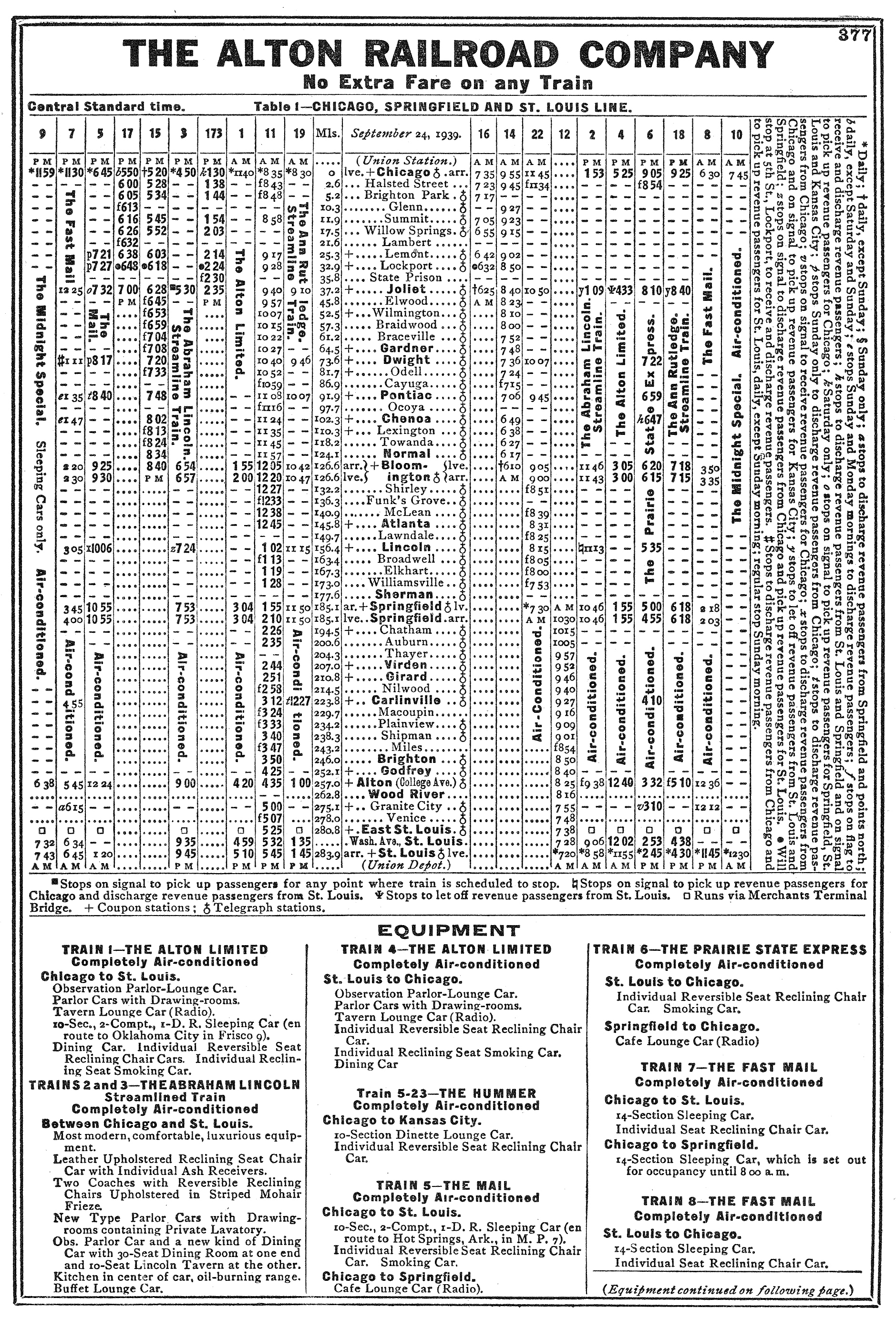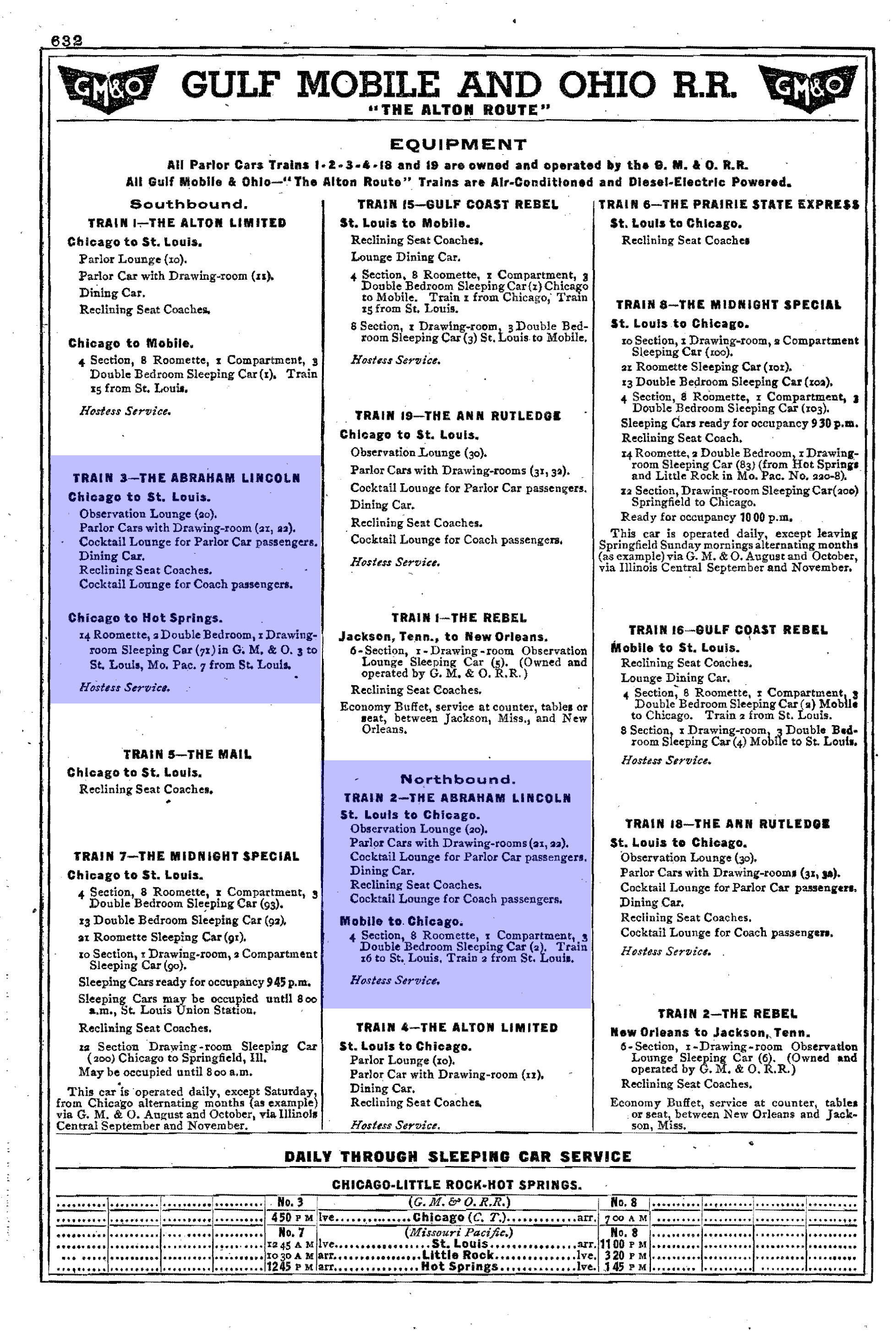"Abraham Lincoln" (Train): Schedule, Consist, Timetable
Last revised: August 24, 2024
By: Adam Burns
Baltimore & Ohio's Abraham Lincoln was one of the railroad's most unique streamliners due to the region it served and its short time under B&O's control.
In 1929 the railroad acquired the bankrupt Chicago & Alton in an effort to gain new markets, namely the St. Louis-Kansas City corridor. The B&O was the only eastern trunk line to reach the latter city.
Unfortunately, it did not provide the the hoped-for market gains. Nevertheless, the B&O looked to exploit its new addition by launching the first-ever streamliner between Chicago and St. Louis.
Alas, even the B&O's legendary service could not sway strong patronage the Lincoln. Additionally, the company had to sell its interest in the Alton by the mid-1940s ending any hopes of benefiting from its new markets.
Interestingly, the train survived as part of the Gulf, Mobile & Ohio and was even retained by Amtrak. Today, a version is still operated today by the national carrier.
Photos
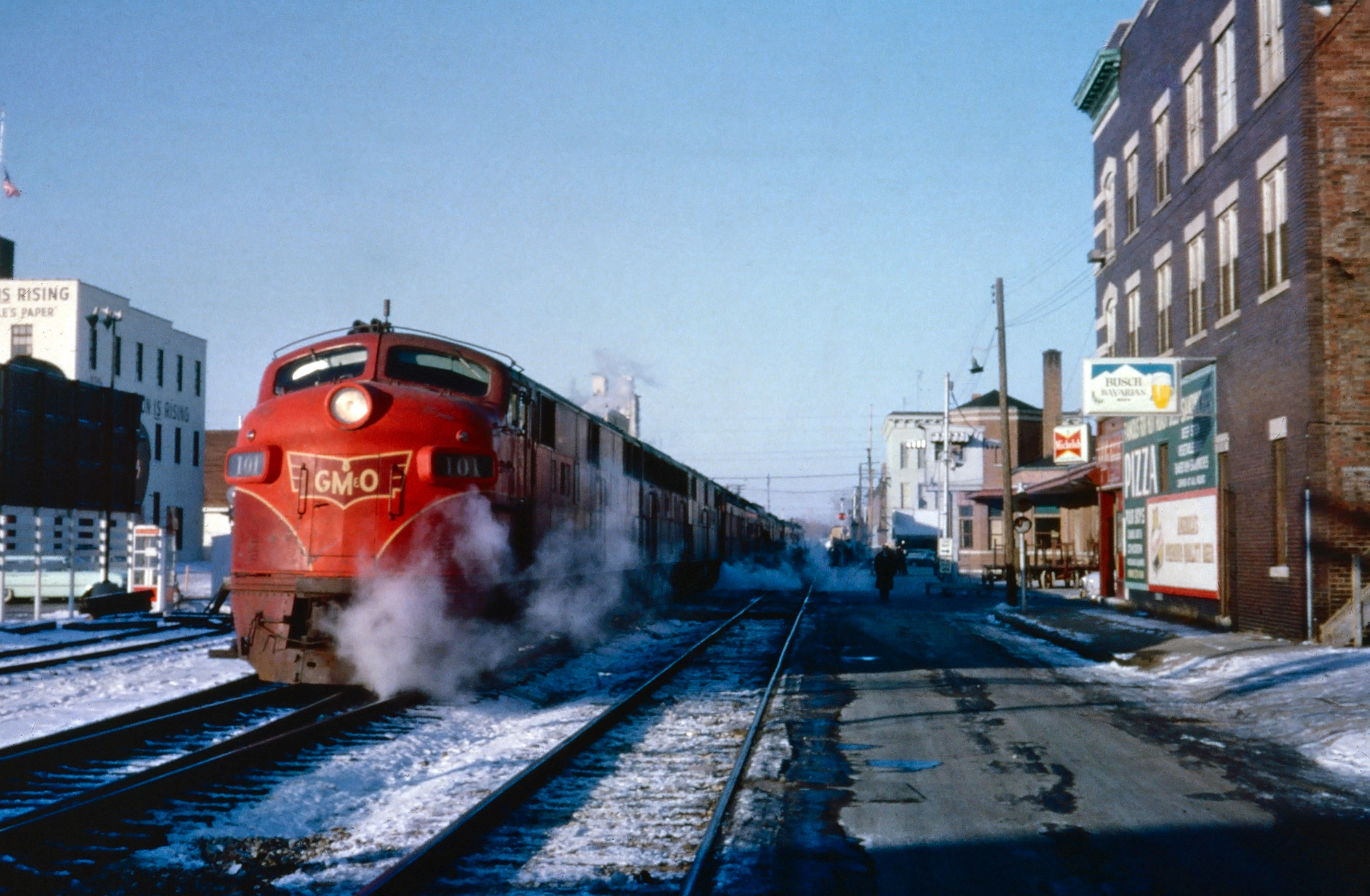 Gulf, Mobile & Ohio E7A #101 has train #3, the southbound "Abraham Lincoln," at Springfield, Illinois, circa 1964. American-Rails.com collection.
Gulf, Mobile & Ohio E7A #101 has train #3, the southbound "Abraham Lincoln," at Springfield, Illinois, circa 1964. American-Rails.com collection.History
What became the B&O's Abraham Lincoln began with the railroad's acquisition of the Chicago & Alton. The C&A's history began with the Alton & Sangamon Railroad, chartered in 1847 to connect Alton, Illinois with St. Louis.
By 1860 the company had been renamed as the St. Louis, Alton & Chicago with intentions of greater expansion. Then, a year later it was purchased by the Chicago & Alton. By the late 1870s the C&A had reached three important Midwestern cities; Chicago, Kansas City, and St. Louis.
In 1929 the United States was thrust into the Great Depression - a national economic collapse which forced many railroads into bankruptcy, including the C&A. At the time the Baltimore & Ohio was under the direction of its most influential president, Daniel Willard.
Throughout his tenure, and continuing through the 1930s, he continued to push expansion in an effort to make the B&O more competitive. It acquired the C&A in 1929, renaming it as the Alton Railroad in 1931.
Timetable and Consist (Alton Railroad)
With its new acquisition the B&O quickly upgraded passenger service across the system. With Union Pacific's and Burlington's unveiling of the streamliner in 1934, the B&O felt the newfangled concept should be brought to the railroad.
In 1935, through the assistance of a U.S. Reconstruction Finance Corporation loan, the B&O purchased two streamlined trainsets from American Car & Foundry.
One featured aluminum-clad equipment and operated on the railroad's crack Royal Blue serving New York-Washington while the other sported Cor-Ten steel. Named the Abraham Lincoln, it was sent west for use on Alton Railroad between St. Louis and Chicago.
Consist (1952)
Overall, the
train included eight cars; a baggage-mail car, three coaches with
reclining seats for 64 passengers each, a diner-lunch counter car,
two parlors, and a round-end parlor-lounge-observation.
For power the train used an 1,800 horsepower semi-streamlined boxcab diesel locomotive built by the Electro-Motive Corporation. Given number 50 it was painted in deep, royal blue with gold trim. The Abraham Lincoln was notable as the first streamlined train to serve St. Louis-Chicago corridor.
Timetable (1952)
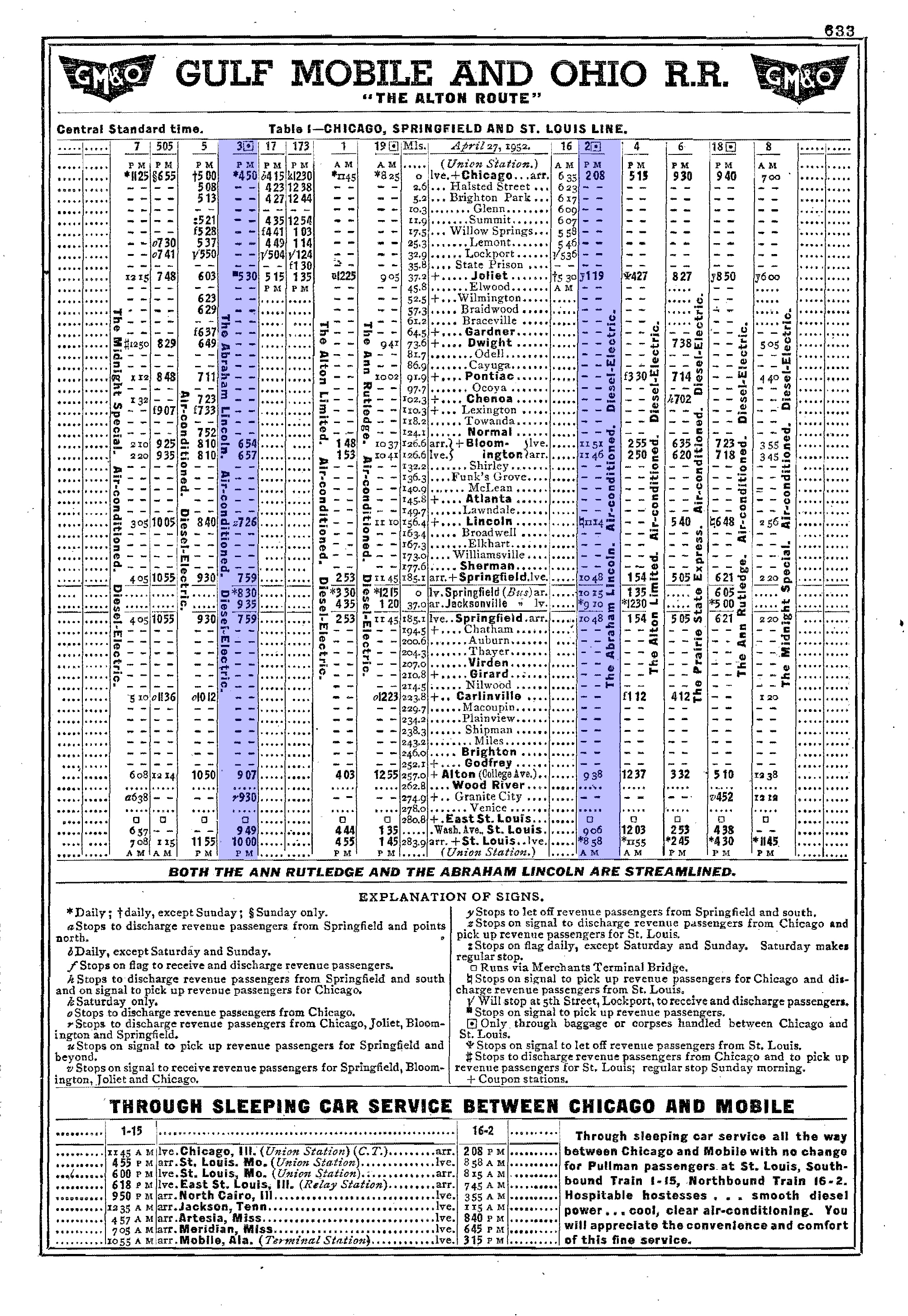
Interestingly, the Alton Railroad soon picked up an additional streamliner when Willard became dissatisfied with the Royal Blue's aluminum trainset and also sent it west in 1937.
With both sets now in service on the Alton, the aluminum was renamed the Abe Lincoln while the original Cor-Ten steel set became the Ann Rutledge (President Lincoln's first love).
In 1937, the Baltimore & Ohio took delivery of six sets of new streamlined diesels from EMC known as the EA (and booster EB) numbered 51-56.
Some of these new unis were assigned to the Abe Lincoln and Ann Rutledge. A two-unit set could produce a combined 3,600 horsepower, which was increased to over 2,000 horsepower per unit.
Typically, the train could complete the run between St. Louis and Chicago in just over five hours averaging a speed of nearly 55 mph.
Unfortunately for the B&O, the Great Depression and the straining demands of World War II put too much stress on the railroad to carry out its plans for the Alton. As a result, the B&O sold its subsidiary to the Gulf, Mobile & Ohio on May 31, 1947.
Interestingly, the GM&O apparently saw the Abe Lincoln as a useful train as it continued to use the name for the next 24 years although it adopted the Alton's red paint scheme as its primary passenger livery.
Timetable (1950)
| Time/Leave (Train #3) | Milepost | Location | Time/Arrive (Train #2) |
|---|---|---|---|
| 4:50 PM (Dp) | 0.0 | 2:08 PM (Ar) | |
| F 5:30 PM | 37.2 | 1:19 PM | |
| 6:57 PM | 126.6 | 11:51 AM | |
| 7:26 PM | 156.4 | F 11:14 AM | |
| 7:59 PM | 185.1 | 10:48 AM | |
| 9:07 PM | 257.0 | 9:38 AM | |
| 9:30 PM | 274.9 | ||
| 9:49 PM | 9:06 AM | ||
| 10:00 PM (Ar) | 283.9 | 8:58 AM (Dp) |
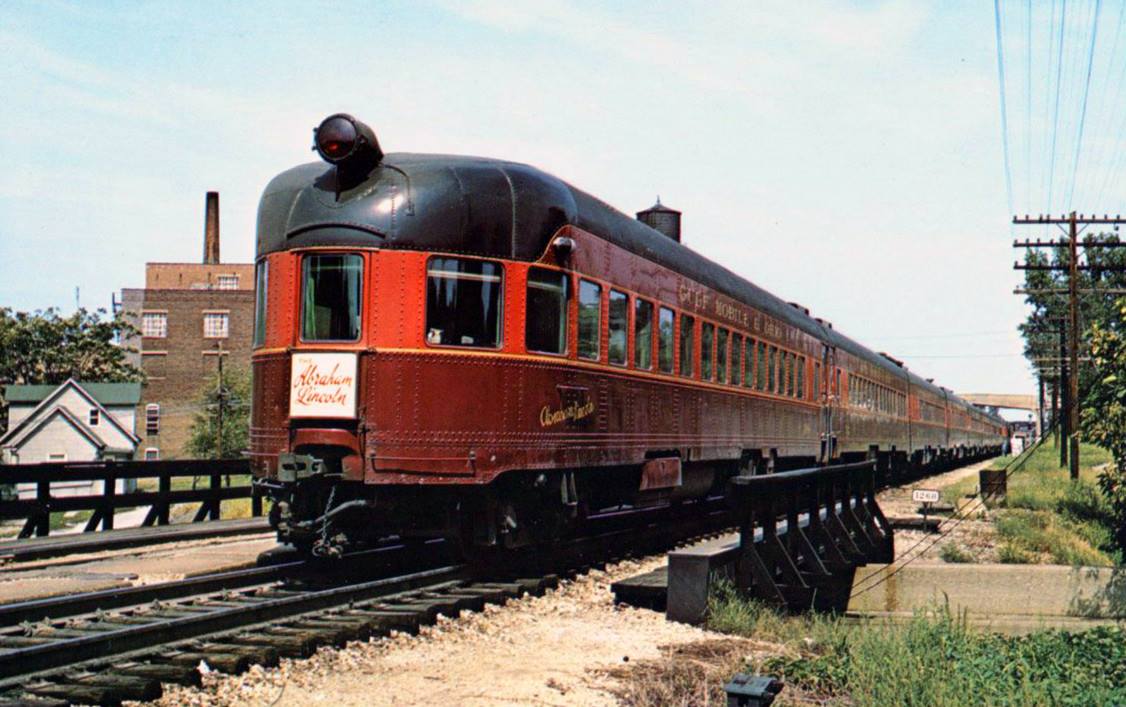 A postcard of the Gulf, Mobile & Ohio's "Abraham Lincoln," circa 1950's. This lightweight parlor-lounge observation was manufactured by American Car & Foundry in 1935.
A postcard of the Gulf, Mobile & Ohio's "Abraham Lincoln," circa 1950's. This lightweight parlor-lounge observation was manufactured by American Car & Foundry in 1935.One of the B&O's original trainsets remained in use until the GM&O began cutting back services in the latter 1960s. Even after Amtrak ownership the Abraham Lincoln continued to operate between St. Louis and Chicago although the carrier also extended the train to Milwaukee.
In 1976, Amtrak even revived the Ann Rutledge and the name survived for decades until 2009 when it - along with the Abe Lincoln - were discontinued and renamed simply as the Lincoln Service.
Still, it's rather amazing that for a train with no, true long term aspirations when it was started by the Baltimore & Ohio all those years ago its route and part of its name continues to survive today.
Sources
- Burns, A.J. and Burns, J.F. Official Guide Of The Railways And Steam Navigation Lines Of The United States, Porto Rico, Canada, Mexico, and Cuba, The. Volume 72. Issue 10. Pages 375-379. New York: National Railway Publication Company, March, 1940.
- Burns, A.J. and Dawson, Leslie. Official Guide Of The Railways And Steam Navigation Lines Of The United States, Porto Rico, Canada, Mexico, and Cuba, The. Volume 85. Issue 3. Pages 628-636. New York: National Railway Publication Company, 1952.
- Johnston, Bob and Welsh, Joe. Art Of The Streamliner, The. New York: Andover Junction Publications, 2001.
- Schafer, Mike. More Classic American Railroads. Osceola: MBI Publishing, 2000.
- Schafer, Mike and Welsh, Joe. Streamliners, History of a Railroad Icon. St. Paul: MBI Publishing, 2003.
- Solomon, Brian. Streamliners: Locomotives And Trains In The Age Of Speed And Style. Minneapolis: Voyageur Press, 2015.
- Welsh, Joe. Baltimore & Ohio's Capitol Limited And National Limited. St. Paul: MBI Publishing, 2007.
Recent Articles
-
Indiana - Whiskey - Train Rides
Dec 23, 25 06:40 PM
Whether you're a local resident or a traveler looking to explore Indiana from a unique perspective, hopping on a whiskey train ride is a journey worth considering. -
California - Wine Tasting - Train Rides
Dec 23, 25 06:33 PM
This article explores the charm, routes, and offerings of these unique wine tasting trains that traverse California’s picturesque landscapes. -
Alabama - Wine Tasting - Train Rides
Dec 23, 25 06:26 PM
While the state might not be the first to come to mind when one thinks of wine or train travel, the unique concept of wine tasting trains adds a refreshing twist to the Alabama tourism scene.

